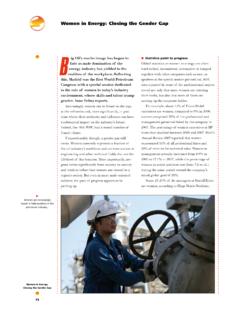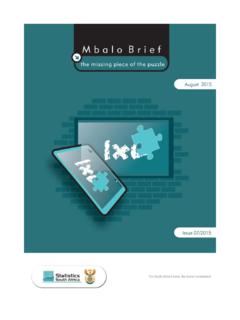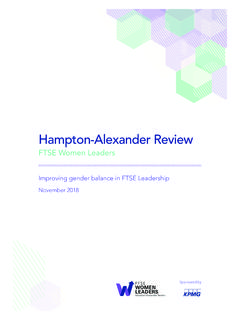Transcription of Module 1: Conceptual framework: gender issues and gender ...
1 Module 1: Conceptual framework: gender issues and gender analysis approaches In this Module , you will: explore the definitions of gender ' and sex';. understand what the key gender issues are in agriculture and food security; and learn about the gender analysis frameworks you will use to address gender issues in climate change research in the agriculture and food security sectors (continued in next Module 2). A. Defining gender gender refers not to male and female, but to masculine and feminine - that is, to qualities or characteristics that society ascribes to each sex. People are born female or male, but learn to be women and men. Perceptions of gender are deeply rooted, vary widely both within and between cultures, and change over time.
2 But in all cultures, gender determines power and resources for females and males (FAO, 2011b). gender is a central organizing factor in societies, and it can significantly affect the processes of production, consumption and distribution. In fact, the influence of gender on rural people's lives and livelihoods is so substantial that by any indicator of human development, female power and resources are lowest in rural areas of the developing world. Rural women make up the majority of the world's poor. Notwithstanding recent improvements in their status, they have the world's lowest levels of schooling and the highest rates of illiteracy. In all developing regions, female- headed rural households are among the poorest of the poor.
3 (FAO, 2011b) Social and economic inequalities between men and women undermine food security and hold back economic growth and advances in agriculture (FAO, 2011a). In other words, gender often constrains women to an unequal position in society in comparison to men. The goal of development interventions, legal and institutional strategies is gender equality. This means equal participation of women and men in decision-making, equal ability to exercise their human rights, equal access to and control of resources and the benefits of development, and equal opportunities in employment and in all other aspects of their livelihoods. Enhancing gender equality and promoting women's empowerment has been enshrined in many international commitments, including the United Nations Millennium Development Goals, the Universal Declaration of Human Rights and the Convention on the Elimination of All Forms of Discrimination Against Women.
4 Despite international commitments, gender inequalities persist. One way toward reducing gender inequalities is through the pursuit of gender equity, which means fairness and impartiality in the treatment of women and men in terms of rights, benefits, obligations and opportunities. By creating social relations in which neither of the sexes suffers discrimination, gender equity aims at improving gender relations and gender roles, and achieving gender equality. The essence of equity is not identical treatment - treatment may be equal or different, but should always be considered equivalent in terms of rights, benefits, obligations and opportunities (FAO, 2011b). FAO recommends that development must encompass rural women's long-term needs and aspirations, their decision-making power, and their access to and control of TRAINING GUIDE - gender AND CLIMATE CHANGE RESEARCH IN AGRICULTURE AND FOOD SECURITY FOR RURAL.
5 DEVELOPMENT, CCAFS & FAO, 2012 1. critical resources such as land and their own labour (Ibid.). The reason for this is that it is typically women's needs that have been overlooked, hence there is a specific need for their inclusion. However, we should also bear in mind that gender equity must consider both men and women. It is important to remember that women's and men's roles are a result of negotiations and relations between them. B. Analysing gender in the agriculture sector gender analysis is the study of different roles and responsibilities of men and women; their differentiated access to and control of resources; and their priority needs to better understand and address gender inequalities (FAO, 2011b).
6 gender analysis requires data on mixed households, as well as on male- and female-headed households. This data is often not directly available, making gender analysis essential. This is why gender -responsive and socially-sensitive climate change research work is important it will help pinpoint data needs and data collection approaches in the context of climate change. gender roles gender is shaped by other social factors, including country/region, ethnic group, age, economic class and religion. gender defines the roles and relations between men and women, as well as boys and girls. gender roles: are socially constructed;. determine social and economic activities;. reflect biological differences.
7 Vary according to regions and cultures; and change over time. gender relations are the ways in which a society defines rights, responsibilities and the identities of men and women in relation to one another. gender relations are based on power and negotiations, and gender roles are closely linked influencing the definition and development of one another. In addition to the roles ascribed to men and women in relation to each other, men and women each have multiple roles (see Box ). While men typically play their roles sequentially, focusing on a single productive role, women must usually play their roles simultaneously, balancing the demands of each within their limited time constraints. The gender -based division of labour ascribed in a given socio-economic setting determines the roles that men and women actually perform.
8 Since men and women play different roles, they often face very different cultural, institutional, physical and economic constraints, many of which are rooted in systematic biases and discrimination (ILO, 1998). TRAINING GUIDE - gender AND CLIMATE CHANGE RESEARCH IN AGRICULTURE AND FOOD SECURITY FOR RURAL. DEVELOPMENT, CCAFS & FAO, 2012 2. Box Men's and women's multiple roles at community level Reproductive role: Childbearing and rearing responsibilities, and domestic tasks done by women, are required to guarantee the maintenance and reproduction of the labour force. This includes not only biological reproduction but also the care and maintenance of the work force (male partner, oneself and working children) and the future work force (infants and school-going children).
9 This work is usually unpaid. Productive role: Work done by both men and women for pay in cash or kind. It includes both market production with an exchange-value, and subsistence or home production with actual use-value, and also potential exchange-value. For women in agricultural production, this includes work as independent farmers, peasant wives and wage workers. The work is both paid (but often underpaid) and unpaid. Community managing role: Activities undertaken primarily by women at the community level, as an extension of their reproductive role, to ensure the provision and maintenance of scarce resources of collective consumption, such as water, energy sources, health care and education.
10 This is unpaid work, undertaken in 'free' time. Community politics role: Activities undertaken primarily by men at the community level, organizing at the formal political level, often within the framework of national politics. This is usually paid work, either directly or indirectly, through status or power. (Moser in ILO, 1998.). In traditional rural societies, commercial agricultural production is mainly a male responsibility. Men prepare land, irrigate crops, and harvest and transport produce to market. They own and trade large animals such as cattle, and are responsible for cutting, hauling and selling timber from forests. In fishing communities, capturing fish in coastal and deep-sea waters is almost always a male domain.
















